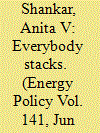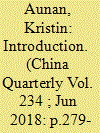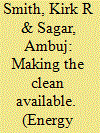|
|
|
Sort Order |
|
|
|
Items / Page
|
|
|
|
|
|
|
| Srl | Item |
| 1 |
ID:
175024


|
|
|
|
|
| Summary/Abstract |
Stove stacking (concurrent use of multiple stoves and/or fuels) is a poorly quantified practice in regions with ongoing efforts to transition household energy to cleaner options. Using biomass-burning stoves alongside clean stoves undermines health and environmental goals. This review synthesizes stove stacking data gathered from eleven case studies of clean cooking programs in low- and middle-income country settings. Analyzed data are from ministry and program records, research studies, and informant interviews. Thematic analysis identifiedy key drivers of stove stacking behavior in each setting. Significant (28%–100%) stacking with traditional cooking methods was observed in all cases. Reasons for traditional fuel use included: costs of clean fuel; mismatches between cooking technologies and household needs; and unreliable fuel supply. National household surveys often focus on 'primary' cookstoves and miss stove stacking data. Thus more attention should be paid to discontinuation of traditional stove use, not solely adoption of cleaner stoves/fuels. Future energy policies and programs should acknowledge the realities of stacking and incorporate strategies at the design stage to transition away from polluting stoves/fuels. Seven principles for clean cooking program design and policy are presented, focused on a shift toward "cleaner stacking" that could yield household air pollution reductions approaching WHO targets.
|
|
|
|
|
|
|
|
|
|
|
|
|
|
|
|
| 2 |
ID:
159834


|
|
|
|
|
| Summary/Abstract |
This introduction provides an overview and analysis of key scientific data regarding air pollution in China. It constitutes a reference for understanding how policymakers, media and population in China make sense of and deal with air pollution, as discussed in the other articles of the section. We summarize the major characteristics and trends regarding air pollution in China, including its main sources and composition, levels of population exposure across the country, attributable mortality, and mitigation efforts. We also compare current levels of air pollution in China with other parts of the world and in a historical perspective. While the situation remains dire in many regions, particularly the Northeast, we conclude that there are signs of relief, or at least a halt to the increase in ambient air pollution levels. At the same time, critical issues regarding unequal levels of exposure remain, and health damaging levels of air pollution in cities will undoubtedly remain high for a long time to come. The rural population residing in areas close to industry and polluted cities and still depending on solid household fuels will likely be the worst off when it comes to air pollution exposure.
|
|
|
|
|
|
|
|
|
|
|
|
|
|
|
|
| 3 |
ID:
136252


|
|
|
|
|
| Summary/Abstract |
Solid cookfuel pollution is the largest energy-related health risk globally and most important cause of ill-health for Indian women and girls. At 700 million cooking with open biomass chulhas, the Indian population exposed has not changed in several decades, in spite of hundreds of programs to make the “available clean”, i.e. to burn biomass cleanly in advanced stoves. While such efforts continue, there is need to open up another front to attack this health hazard. Gas and electric cooking, which are clean at the household, are already the choice for one-third of Indians. Needed is a new agenda to make the “clean available”, i.e., to vigorously extend these clean fuels into populations that are caught in the Chulha Trap. This will require engaging new actors including the power and petroleum ministries as well as the ministry of health, which have not to date been directly engaged in addressing this problem. It will have implications for LPG imports, distribution networks, and electric and gas user technologies, as well as setting new priorities for electrification and biofuels, but at heart needs to be addressed as a health problem, not one of energy access, if it is to be solved effectively.
|
|
|
|
|
|
|
|
|
|
|
|
|
|
|
|
|
|
|
|
|